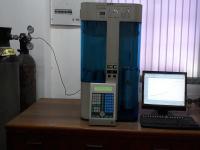
Functional Material
Functional Materials group studies solids, liquids and their interfaces before, during and after reactions involving 1D, 2D and 3D materials in nanoscale for sustainable development covering energy, environment and health sector. Sole objective of this program is to meet growing energy demand and to reduce the environmental burden on society using innovative functional materials and green process. Research includes functionalization in nanoscale to reduce surface energy, understanding dynamics on surfaces as they pertain to alloy formation, film deposition, exfoliation of sheets, porous nanomaterial and biomaterial synthesis. The group also undertakes collaborative research with industries, mainly in the area of functional materials for energy saving, storage, generation and involving different nanomaterials. presenly group is working in association with national and international industries, PSUs, DST and CSIR. Group have contributed several publications, patents and technologies (three commercialized). .
Biomaterials
Work on biomaterials was focused on (a) nanosized hydroxyapatite/β Tri calcium phosphate for orthopedic and orthodontic applications and (b) nanosized iron oxides as MRI contrast enhancers and Magnetic Hyperthermia for killing of cancer cells. We have more than 75 publications on biomimetic synthesis and transferred about 8 technologies out of which two are commercialized. Worked on scalable exfoliation of graphene using proteins in association with one industry from Sri Lanka. Recently group is working on the development of high strength (UTS > 200 MPa) magnesium alloys for biodegradable implant application in collaboration with industries. Encouraging result shows the hope of commercialization of the magnesium based biodegradable implant in near future. Looking at the pressing need of the society due to coronavirus pandemic we have initiated work on nanomaterial based long term disinfectant/ sanitizer for protective application in public places.
Porous nanomaterials
Group is working on synthesis and surface chemistry of porous materials with different shapes and sizes as adsorbents and catalysts for environmental remedies and green hydrogen energy. Material synthesis by sol-gel, hydrothermal and controlled anodisation techniques. In the area of environmental remedies different porous materials like pillared clay, LDH and TiO2 based mixed oxides, MOFs as adsorbent and photocatalysthas been explored with improved efficiency. Uniform sized 1D TiO2 and Al2O3 nanotubes have been developed through anodisation technique with tunable length, diameter and bandgap for multifunctional application. One can fabricate sponge, single layer to double layers nanotubes with bamboo structure by choosing the right solvent, additive, applied potential and time of anodisation. We are also exploring the possible application of photocatalysis for antiviral application.
Energy Materials
Presently the group is looking towards exploring different nanomaterials including 2D materials such as graphene, metal chalcogenides and MXenes for energy saving, generation and storage application. Transparent graphene based conductive coating with high megneto-resistance was developed. Developed energy saving induction heated soleplate using graphene based composites for clothe iron in collaboration with industries. Easy and scalable techniques for the exfoliation of metal chalcogenides with stable aqueous dispersion is achieved. Composites involving 2D nanomaterials are explored for improved water splitting under solar light for green hydrogen generation. Another frontline area of the group is to understand the fundamentals of charge storage mechanisms, and to overcome the technological barriers in developing next-generation electrical storage systems like “supercapacitors” and “batteries” using composite nanomaterials. We are working with graphene, carbon nanotubes, MXenes, transition metal oxides and sulphides etc. to develop both the cathodes and anodes for high performing energy storage devices. Looking at the importance of MXene, we are also developing indigenous process for the production of layered transition metal carbides / nitrides / carbonitrides as starting material (MAX).














